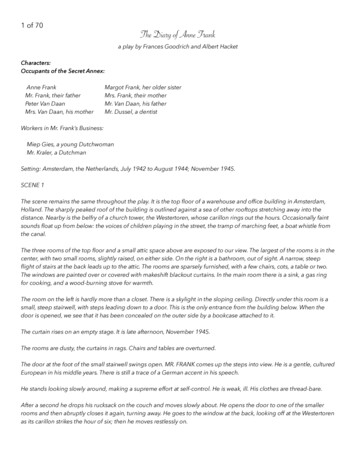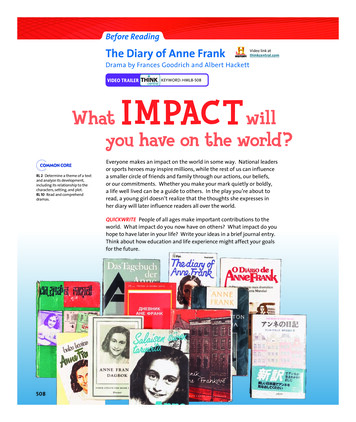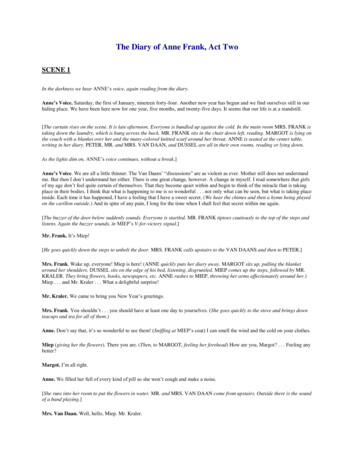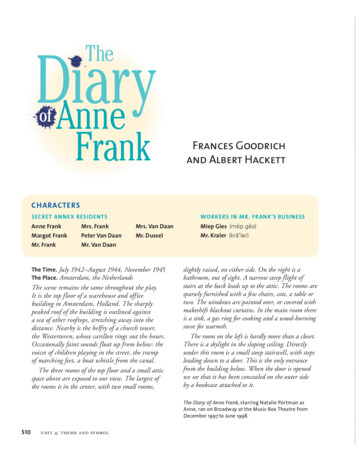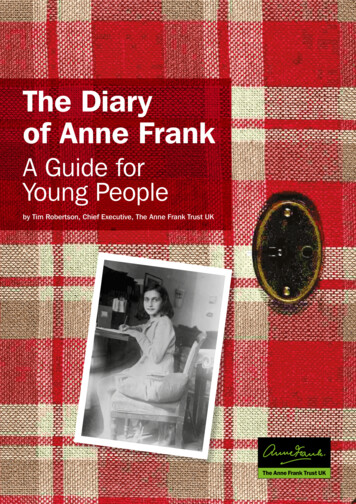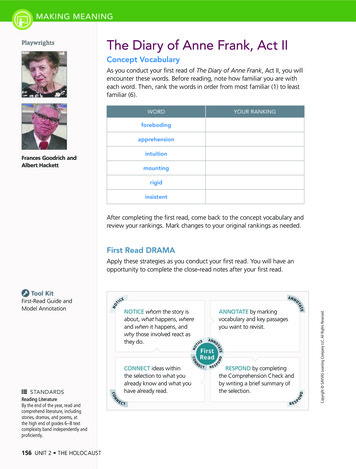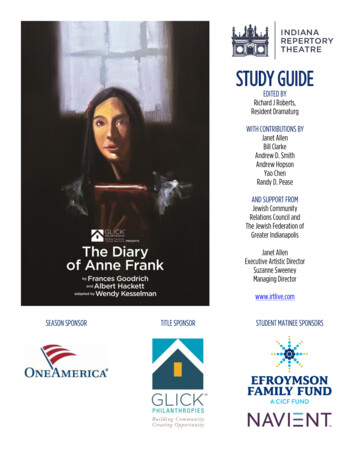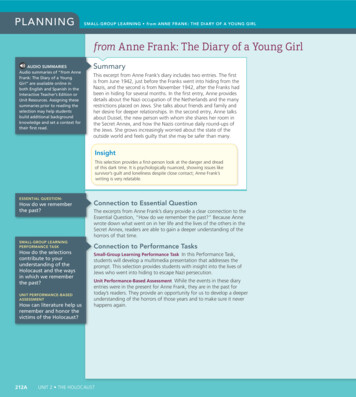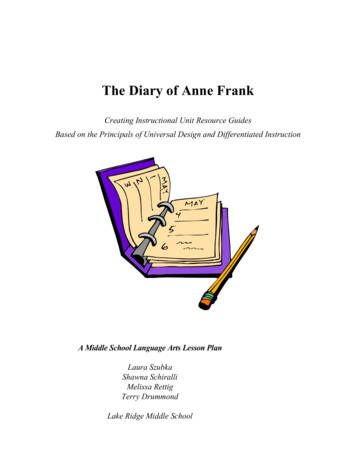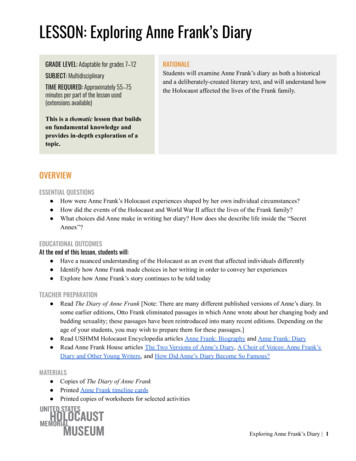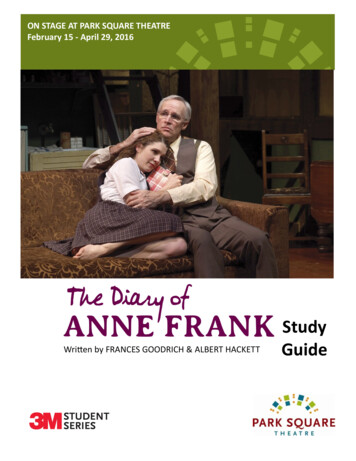
Transcription
ON STAGE AT PARK SQUARE THEATREFebruary 15 - April 29, 2016Written by FRANCES GOODRICH & ALBERT HACKETTStudyGuide
ContributorsPark Square TheatreStudy Guide StaffEDITORMary Finnerty (Director of Education)COPY EDITORMarcia AubineauCONTRIBUTORSTom Brandt*, Sam DiVita*, Amy HewettOlatunde*, Cheryl Hornstein*, RichardNicolai*, Anne Heath*, Laura Johnson*,Tim Marburger*, Matt Sciple, LeischenSopoci*, Lee Woolman*; imagescompiled by Ami ChristensenCOVER DESIGN AND LAYOUTNaomi Campion (Education Sales andServices Manager)& Emilie Moravec, Ryan Ripley* Past or Present Member of thePark Square Theatre Teacher Advisory BoardContact UsPARK SQUARE THEATRE408 Saint Peter Street, Suite 110Saint Paul, MN 55102EDUCATION: ksquaretheatre.orgIf you have any questions or comments aboutthis guide or Park Square Theatre’s EducationProgram, please contactMary Finnerty, Director of EducationEMAILPHONE 651.767.8494finnerty@parksquaretheatre.orgPark Square TheatreTeacher Advisory BoardMarcia AubineauUniversity of St. Thomas, retiredTheodore FabelSouth High SchoolCraig FarmerPerpich Center for Arts EducationAmy Hewett-OlatundeLEAP High SchoolsCheryl HornsteinFreelance Theatre and Music EducatorAlexandra HowesTwin Cities AcademyDr. Virginia McFerranPerpich Center for Arts EducationKristin NelsonBrooklyn Center High SchoolMari O’MearaEden Prairie High SchoolDr. Kirsten Pardun-JohannsenPerforming Arts Specialist, Orono SchoolJennifer ParkerFalcon Ridge Middle SchoolMaggie QuamHmong College Prep AcademyKate SchillingMound Westonka High SchoolJack SchlukebierCentral High School, retiredElizabeth SealMounds Park AcademyTanya SponholzPrescott High SchoolJill TammenHudson High School, retiredCraig ZimanskeForest Lake Area High Schoolwww.parksquaretheatre.org page 2
Study GuideThe Diary of Anne Frank Study GuideContentsHistorical Context4. A History of Anne Frank’s Diary6. What Really Happened? The Play vs. History9. From the Page to the Stage: Creating a Play from Anne Frank’s Diary11. A Timeline of Events15. Eight Stages of Genocide18. Identifying Oppression in the Early StagesLife in the Annex19. What Was It Like to Live in the Annex?21. A Diagram of the Dimensions and Layout of the Secret Annex22. Floor Plans: Bloomgarden’s 1955 and Backlund’s 1999 set designs for Diary23. Images of the Secret Annex24. Through Anne’s Eyes: Annotated Video ResourcesUnderstanding Culture25. Judaism and Jewish Culture in the Play26. An Explanation of the Holiday of Hanukkah27. Making Anne Universal: What Did We Lose by Secularizing Anne Frank?Activities and Resources28. Anne Frank and Sadako Sasaki31. Who is Responsible? Assessing Levels of Responsibility33. Tossing Lines: A Pre-Play Class Activity35. Pre-Play Text Analysis: Scene to Read Aloud39. Classroom Activity Ideas for The Diary of Anne Frank41. Writing Topics for The Diary of Anne Frank42. Annotated Bibliography of Resourceswww.parksquaretheatre.org page 3
A History of Anne Frank’s DiaryAnne Frank kept her diary from June 12, 1942 to August1, 1944. She received the diary for her 13th birthdayand started writing in it right away, unaware that in a monthshe would be forced into hiding with her family becauseHitler’s Nazis would try to imprison them for being Jewish.Anne recorded her innermost feelings in her diary, whichshe named “Kitty.”At first Anne wrote strictly for herself, but after hearing aradio broadcast calling for ordinary citizens to provide theirdiaries after the war for historical purposes, Anne rewrote it,editing and improving the text, omitting passages she didn’tthink were interesting enough, and at the same timeMiep Gieskeeping it up to date. She changed the names of the hidersand helpers for the rewrite. (Hiders: Mr. Pfeffer to Albert Dussel, Mr. and Mrs. Van Pels to Mr.and Mrs. Van Daan, and Peter Van Pels to Peter Van Daan. Helpers: Miep Gies to Miep VanSanten, Bep Voskuijl to Elli Vossen, Johannes Kleiman to Mr. Koophuis and Victor Kugler to Mr.Kraler.)On August 4, 1944, the eight people hiding in the Secret Annex were arrested. Miep Gies andBep Voskuijl, the two secretaries working in the building, found Anne’s diary before the Nazisransacked the annex, and Miep hid it for safekeeping.Miep did not read the diary because she knew itincriminated the people who had helped those in hidingand that if she read it she would have to burn it in orderto protect their lives.Otto Frank, Anne’s father, returned to the annex afterthe war and found he was the only one of the eight tosurvive the concentration camps. Miep Gies gave himwhat was left of Anne, her diary.Otto Frank in the attic after the warAfter much deliberation, Otto Frank decided to publishAnne’s diary so that readers would learn about theeffects of the Nazi regime and its process ofdehumanization. However, in the immediate aftermathof the war, it wasn’t easy for Mr. Frank to find apublisher; he was told that no one wanted to readabout the Holocaust. When a newspaper finally printeda story about Anne’s diary, it captured the interest of aCONTINUED.www.parksquaretheatre.org page 4
HISTORICAL CONTEXTA History of Anne Frank’s DiaryCONTINUEDDutch firm, Contact Publishers, which published it in June of 1947 using Anne’s chosen title, TheSecret Annex. This edition included Anne’s rewritten version and parts of the original diary, butseveral passages dealing with Anne’s sexuality were omitted as it was not customary to writeopenly about sex at that time. Mr. Frank also omitted some unflattering passages about his wifeand the other people of the Secret Annex, the Van Pels family and Fritz Pfeffer, but he did retainthe fictional names that Anne had created for them. At first only 1,500 copies of the diary wereprinted, but demand was so great that another edition was quickly produced.After Otto Frank died in 1980, The Anne Frank Foundation in Switzerland, which was Otto Frank’ssole heir, inherited his daughter’s copyrights and published a new expanded edition of the diary in1986, containing all of the entries that Otto Frank and Contact Publishers had removed from theoriginal 1947 edition.Neo-Nazi groups have targeted Anne Frank’s diary, questioning its authenticity in order to denythe full implications of the Holocaust. In response to these claims, the Netherlands Institute forWar Documentation had tests performed on the paper, ink and glue used in the diary, proving thatit was written during the 1940s. Tests were also performed on Anne’s handwriting. The scientificstudy proved that the diary was indeed written by Anne Frank during the Holocaust. The 1986edition also includes transcripts of these tests which verify the authenticity of the diary.In 1995, on the 50th anniversary of Anne Frank’s death, The Diary of a Young Girl: The DefinitiveEdition was published. This edition restored the diary entries that Otto Frank and the originalpublishers had removed which dealt with Anne’s honest feelings toward her family, herburgeoning womanhood, and her reflections on her Judaism and the Holocaust. The ChicagoTribune wrote, “The new edition reveals a new depth to Anne’s dreams, irritations, hardship andpassions.”During the months Anne lived in hiding, her diary became her best friend and confidant. Sherewrote some diary entries into stories and also wrote some fantasy stories. All of her stories arenow published. Today Anne Frank’s diary has been translated into 55 languages and is one of themost widely read books in the world.By Matt SciplePark Square Theatre Literary Manager, 1995-2000www.parksquaretheatre.org page 5
What Really Happened?A COMPARISON OF EVENTS IN THE PLAY TO THE DIARYBased on and including many of the actualwords contained in Anne Frank’s Diary of aYoung Girl, Goodrich and Hackett’s play, The Diaryof Anne Frank, is a theatrical adaptation. It altersand selectively omits several entries and eventsfrom its source material. All the changes wereapproved by Anne’s father, Otto Frank, who wasan advisor for the original production. Examinethe changes and discuss the reasons they mighthave been made.Pages from Anne’s DiaryIn the PlayIn HistoryAnne receives the diary for the firsttime in the Secret Annex. Its first entryis dated July 6, 1942.The diary was a birthday present. The first entry isdated June 12, 1942 when the Franks were stillliving in their home and Anne was still in school.The Franks go into hiding because ofthe general danger of their situation.In the entries dated July 8 and July 9, 1942, it isexplained that the Franks have to go into hidingearlier than originally planned because Margotreceived a “call-up notice from the SS.”The Van Daans are in the annex first,impatiently awaiting the Franks’ arrival.The Franks entered the annex on July 9 and the VanDanns (Van Pels) arrived on July 12.The arrival of Dussel is a surprise to theFranks; Mr. Kraler brings him, saying,“It’s just a night or two, until I find someother space. This happened so suddenlythat I didn’t know where to turn.” (ActI, Scene 3).Mr. Dussel’s (Fritz Pfeffer’s) arrival was wellplanned: “We always thought there was enoughroom and food for one more we chose adentist” (11/10/42).Dussel says, “I’m a man who has alwayslived alone. I haven’t had to adjustmyself to others” (Act I,Scene 3).Fritz Pfeffer, “Alfred Dussel” in Anne’s Diary, hadone son, Peter, and a fiancée, Charlotta Kaletta,who was a Christian. Fritz and Charlotta could notwed because under the Nazi’s Nuremberg Laws,intermarriage was considered a criminal offense.CONTINUED.www.parksquaretheatre.org page 6
HISTORICAL CONTEXTWhat Really Happened?In the PlayIn HistoryThere is only oneoccasion where theattic inhabitantsfear discovery.There were several instances whenAnne and the others feared discovery:“Our German visitors were back lastSaturday ” (4/27/43).“Mr. Kugler thinks this burglar belongsto the same gang as the one whomade an unsuccessful attempt sixweeks ago to open all threedoors” (5/16/43).“Mr. Van Maaren, the man who worksin the warehouse, is getting suspiciousabout the Annex ” (9/16/43).Anne expresseslittle curiosity aboutthe act of sex or thephysical changes inher body.Anne’s interest inPeter is moreromantic thansexual and remainsvery innocentexcept for a briefkiss on the cheek,which he initiates.The only physicalact they discuss iskissing.Anne’s personal feelings about herblossoming sexuality were edited outof the original diary:Anne at her school desk in“I think what’s happening to me is soAmsterdam, 1940wonderful, and I don’t just mean thechanges taking place on the outside ofmy body, but those on the inside. When I lie awake at night I feel aterrible urge to touch my breasts and listen to the quiet, steadybreathing of my heart Every time I see a female nude, such as theVenus in my art history book, I go into ecstasy ” (1/6/44).“Soon after I turned eleven, they told me about menstruation. But eventhen, I had no idea where theblood came from or what it wasfor” (3/18/44).Anne and Peter compare sexualknowledge and she quizzes himabout the male body: “[Peter]told me a lot about what hecalled Prasentivmitteln[prophylactics]” (3/23/44).“I don’t know how I suddenlymade the right movement, butbefore we went downstairs he[Peter] gave me akiss” (4/16/44).The Frank FamilyCONTINUED.www.parksquaretheatre.org page 7
HISTORICAL CONTEXTWhat Really Happened?In the PlayIn HistoryAnne’s recorded voicein the play is heardsaying, “I still believe,in spite of everything,that people are reallygood at heart,” towhich Mr. Frankresponds, “She puts meto shame.”Anne’s diary actually reads, “It’sdifficult in times like these: ideals,dreams and cherished hopes risewithin us, only to be crushed bygrim reality. It’s a wonder I haven’tabandoned all my ideals; theyseem so absurd and impractical.Yet I cling to them because I stillbelieve, in spite of everything, thatpeople are truly good at heart. It’sutterly impossible for me to buildmy life on a foundation of chaos,suffering and death. I see theThe view from the attic windowworld as slowly being transformedinto a wilderness, I hear thatapproaching thunder that, one day, will destroy us too, I hear thesuffering of millions. And yet, when I look up at the sky, I somehowfeel that everything will change for the better ” (7/15/44).“There’s a destructive urge in people, the urge to rage, murder andkill” (5/3/44).Anne idealizes herfather and squabblesoccasionally with hermother.In several entries, Anne discussesher parents’ marital difficulties.Anne says, “We’re notthe only people thathave had to suffer.There’ve always beenpeople that have hadto sometimes onerace sometimesanother.”“In the eyes of the world, we’redoomed, but if after all thissuffering, there are still Jews left,Tombstone for Anne and Marthe Jewish people will be held up asgot at the Bergen-Belsen Memorial sitean example. Who knows, maybe ourreligion will teach the world and allthe people in it about goodness, and that’s the reason, the onlyreason we have had to suffer. We can never be just Dutch, or justEnglish, or whatever, we will always be Jews as well. And we’ll haveto keep on being Jews, but then, we’ll want to be. God has neverdeserted our people. Through the ages Jews have had to suffer, butthrough the ages they’ve gone on living, and the centuries ofsuffering have only made them stronger” (4/11/44).By Matt SciplePark Square Theatre Literary Manager, 1995-2000www.parksquaretheatre.org page 8
From the Page to the Stage:CREATING A PLAY FROM ANNE FRANK’S DIARYDiary of a Young Girl: An Instant ClassicIn 1952, Doubleday published the first American edition of AnneFrank: The Diary of a Young Girl; this translation included cuts thatOtto Frank and the original European publishers had made. Thenovelist, Meyer Levin, wrote a front page essay, “The Child Behindthe Secret Door,” for The New York Times Book Review proclaimingthe importance of the work: "Anne Frank's diary is too tenderlyintimate a book to be frozen with the label 'classic' and yet no otherdesignation serves . Anne Frank's voice becomes the voice of sixmillion vanished Jewish souls." The response was enormous, and45,000 copies were sold within a short time.The Road to the StageWith the instant success of the book, producers and theatricalagents were anxious to gain rights to produce a play or film basedon Anne Frank’s diary. Meyer Levin, who had done so much toAnne Frankpromote the book, wrote a play based on Anne’s diary and broughtit to Otto Frank and Doubleday to produce. Through a series ofcomplicated events, which are still in dispute, Levin was turneddown. For decades, Levin continued to argue that his play, because it was less sanitized than theBroadway version and because it kept Anne’s Jewishness central to the story, was a moreauthentic adaptation of the diary. When Levin’s version of the script was rejected by severalproducers, it strengthened Otto Frank’s determination to accentuate the universal elements ofAnne’s story.Hollywood Screenwriters Hired to Adapt the Diary“It is not a Jewish book. So do notmake a Jewish play out of it.”—Otto FrankSince the original Diary of a Young Girl was first published, it hasbeen surrounded by controversy. Otto Frank’s decision to stressthe story’s optimism and its universality left many Jewishreaders feeling cheated. This feeling grew with the diary’stheatrical adaptation. In addition to being non-Jews, Goodrichand Hackett, the husband and wife playwriting team assigned todramatize Anne’s story, were the screenwriters of popularHollywood fare like The Thin Man and It’s a Wonderful Life.Goodrich and Hackett worked with playwright Lillian Hellman,Garson Kanin (the production’s director), and Otto Frank ontheir adaptation. Among other changes, their play removedmany details about the Frank family’s Jewishness. “The fact thatin this play the symbols of persecution are Jews is incidental,”CONTINUED.www.parksquaretheatre.org page 9
HISTORICAL CONTEXTFrom the Page to the StageCONTINUEDsaid Garson Kanin. Otto Frank himself was quoted as saying, “Itis not a Jewish book. So do not make a Jewish play out of it.”Though their first drafts emphasized the mischievous side ofAnne’s personality, the final version emphasized her optimismand idealism. Goodrich and Hackett, along with Kanin, visitedthe annex with Otto Frank, who answered their manyquestions about the annex and those who had hidden there.The Diary of Anne Frank: 1955On October 5, 1955, The Diary of Anne Frank opened onBroadway starring Joseph Schildkraut as Otto Frank and SusanStrasberg as Anne. Praise for the production was widespread.The play went on to win the 1955 Pulitzer Prize for Drama, aswell as three Tony Awards, including Best Play of the 1955-56Season. The Diary of Anne Frank eventually played a total of717 performances on Broadway before being producedAnne Frankthroughout America and the world in professional and amateurtheaters. Brooks Atkinson in The New York Times called theplay a “tender, rueful, moving drama. It’s strange how the shining spirit of a young girl now deadcan filter down through the years and inspire a group of theatrical professionals in a foreign land.”New York Herald Tribune drama critic Walter Kerr wrote, “Frances Goodrich and Albert Hacketthave fashioned a wonderfully sensitive narrative out of the real life legacy left us by a spirited andstraightforward Jewish girl. A play that is—for all its pathos—as bright and shining as a banner.”Anne’s Legacy: A “Universal, Idealistic Figure”“As bright and shining as a banner,” “warm,” “tender”—these became descriptions not only of theplay, but of Anne Frank. The words, “In spite of everything, I still believe that people are good atheart” (lifted out of context), encapsulate the image of Anne Frank as a universal, idealistic figure.The play was the first popularization of the events of the Holocaust. As such, it was very much aproduct of its time; it embraced a sense of assimilation and universalism. In 1959, the film versionstarring Millie Perkins as Anne Frank was directed by George Stevens.(See Meyer Levin, The Obsession, 1973). For two differing analyses of this controversy and the roleof playwright Lillian Hellman and others, see An Obsession with Anne Frank, Meyer Levin and theDiary, Lawrence Graver, (Univ. of Ca. Press, 1996) and The Stolen Legacy of Anne Frank: MeyerLevin, Lillian Hellman, and The Staging of the Diary, Ralph Melnick, (Yale Univ. Press, 1997).By Matt SciplePark Square Theatre Literary Manager, 1995-2000www.parksquaretheatre.org page 10
A Timeline of EventsIN EUROPE AND IN THE LIFE OF THE FRANK FAMILYNovember 11, 1918End of World War I.January 1923The Nationalist Socialist German Workers’ Party,known as the Nazi Party, holds its first rally inMunich.May 12, 1925Otto Frank and Edith Hollander are married inAachen, Germany.Fall 1925Mein Kampf, Hitler’s autobiography and antiSemitic plan, is published.February 16, 1926The Franks’ first daughter, Margot, is born inFrankfurt, Germany.June 12, 1929October 29, 1929July 31, 1932January 30, 1933February 1933Spring 1933April 1933May 10, 1933Otto and Edith Frank in 1925The Franks’ second daughter, Annelies Marie, orAnne, is born in Frankfurt, Germany.“Black Tuesday.” The American Stock Marketcrashes, wiping out the fortunes of investorsovernight and starting a worldwide economicdepression.The Nazis receive 37.4% of the vote and areasked to form a coalition government.Hitler is appointed Chancellor of Germany.Anne, Edith, and Margot in Frankfurt in 1933Freedom of speech and assembly is suspended bythe Nazi government.The Gestapo (Secret State Police) is established.Dachau, the main concentration camp forpolitical prisoners, is built.The Nazis declare a boycott of Jewish businessesand medical and legal practices. A law excludingnon-Aryans removes Jews from government andteaching positions.Books by Jews, political enemies of the Nazistate, and other “undesirables” are burned inhuge rallies throughout Germany.Anne at her desk at theMerwedeplein in AmsterdamCONTINUED.www.parksquaretheatre.org page 11
HISTORICAL CONTEXTA Timeline of EventsCONTINUEDSummer 1933The Franks decide the family must move to the Netherlands due to increasingtensions in Germany.January 1934Forced sterilization of the racially “inferior,” primarily ROMA (“Gypsies”), AfricanGermans, and the “unfit” (the mentally and physically disabled), begins.Fall 1935The Nuremberg Laws are passed defining Jews as non-citizens and making anymarriage between Aryans and Jews illegal.August 1, 1936The Olympic Games open in Berlin. Anti-Semitic signs are removed during thegames.March 12, 1938Germany annexes Austria.November 9-10,1938Kristallnacht, a state-sponsored pogrom in Germany and Austria, results insynagogues and Jewish-owned businesses being looted and destroyed, and30,000 Jews transported to concentration camps.March 15, 1939The Nazis occupy Czechoslovakia.September 1, 1939September 1939April and May 1940December 7, 1941December 11, 1941March 1942June 12, 1942July 5, 1942Germany invades Poland. World War II begins.Hitler implements the “Tiergarten 4” program, killing the institutionalized,physically disabled and mentally handicapped.Germany invades Denmark, Norway, the Netherlands, France, Belgium andLuxembourg. Jewish children are made to wear the yellow star.Japan attacks the U.S. fleet at Pearl Harbor. The next day the United States entersWorld War II.Germany declares war on the U.S.Sobibor, Belzec and Auschwitz-Birkenau all become fully operational deathcamps, followed by Treblinka in July.Anne Frank receives a diary for her thirteenth birthday.Margot receives a call-up notice to report for deportation to a labor camp. Thefamily goes into hiding the next day.CONTINUED.www.parksquaretheatre.org page 12
HISTORICAL CONTEXTA Timeline of EventsJuly 13, 1942The Van Pels family (called Van Daan in Anne’sdiary), another Jewish family originally fromGermany, joins the Frank family in hiding.November 16, 1942Fritz Pfeffer (called Alfred Dussel by Anne), theeighth and final resident of the Secret Annex, joinsthe Franks and Van Pels.June 1943SS leader Himmler orders the “liquidation” of allthe Jewish ghettos in Poland and the Soviet Unionby forcing their residents into death camps.June 6, 1944August 4, 1944September 3, 1944September 1944October 1944The allies invade Western Europe (D-Day).The residents of the Secret Annex are betrayed andarrested. They are taken to a police station inAmsterdam and eventually to the WesterborkTransit Camp.The eight prisoners are transported in a sealedcattle car to Auschwitz. This would be the lasttransport to ever leave Westerbork.Anne and Margot Frank are transferred to theBergen-Belsen Concentration Camp.Himmler orders troops to destroy the crematoria atAuschwitz to hide the Nazi war crimes.December 20, 1944Fritz Pfeffer dies at the NeuengammeConcentration Camp in Germany.January 27, 1945Hermann Van PelsHermann Van Pells (Mr. Van Daan) is murdered inthe gas chambers shortly after arriving atAuschwitz.November 26, 1944January 6, 1945Mrs. Van PelsPeter Van PelsEdith Frank dies at Auschwitz-Birkenau, thewomen’s subcamp.Otto Frank is liberated from Auschwitz by theRussian Army. He is taken first to Odessa and thento France before he is allowed to make his wayback to Amsterdam.Fritz PfefferCONTINUED.www.parksquaretheatre.org page 13
HISTORICAL CONTEXTA Timeline of EventsCONTINUEDMarch 1945Anne and Margot Frank die at Bergen-Belsen within days of each other.Spring 1945Mrs. Van Pels dies at the Theresienstadt camp in Czechoslovakia.Peter Van Pels, after surviving a death march from Auschwitz, dies in Austria at theMauthausen Concentration Camp, just days before it was liberated.May 5, 1945Germany surrenders, and the war ends in Europe, less than two months afterAnne’s death.May 7, 1945Otto Frank arrives in Amsterdam, where he is reunited with Miep and Jan Gies. Heconcentrates on finding Margot and Anne.June 3, 1945Otto Frank visits a Mrs. Brilleslijper who was with his daughters in Bergen-Belsen.She tells him of Anne’s and Margot’s deaths in Bergen-Belsen.August 1945The Nuremberg Trials of Nazi war criminals begin.November 1945Summer 1947Fifteen hundred copies of Anne’s diary are published by Contact Publishers inAmsterdam.The diary is translated into English.1955The Diary of Anne Frank, a play by Goodrich and Hackett, opens on Broadway.1959The American film version of Diary is produced with Millie Perkins as Anne.August 19, 1980Otto Frank dies in Switzerland.This timeline is adapted from the internet Study Guidefor the 1997 Broadway revival of The Diary of Anne Frank.www.parksquaretheatre.org page 14
Eight Stages of GenocideBy Gregory H. Stanton (Originally written in 1996 at the Department of State; presented at the Yale UniversityCenter for International and Area Studies in 1998)For a primary Source document of Eight Stages of Genocide by Gregory H. Stanton, stagesofgenocide.htmlGenocide is a process that develops in eight stages that are predictable but not inexorable. At each stage,preventive measures can stop it. The later stages must be preceded by the earlier stages, though earlierstages continue to operate throughout the process. The following stages, definitions and preventivemeasures were written in 1996 at the Department of State and presented by Gregory H. Stanton.The eight stages of genocide tage One: ClassificationAll cultures have categories to distinguish people into "us and them" by ethnicity, race, religion, or nationality:German and Jew, Hutu and Tutsi. Bipolar societies that lack mixed categories, such as Rwanda and Burundi,are the most likely to have genocide. The main preventive measure at this early stage is to developuniversalistic institutions that transcend ethnic or racial divisions, that actively promote tolerance andunderstanding, and that promote classifications that transcend the divisions. The Catholic church could haveplayed this role in Rwanda, had it not been driven by the same ethnic divisions as Rwandan society.Promotion of a common language in countries like Tanzania or Cote d'Ivoire has also promoted transcendentnational identity. This search for common ground is vital to early prevention of genocide.Stage Two: SymbolizationWe give names or other symbols to the classifications. We name people "Jews" or "Gypsies," or distinguishthem by colors or dress, and apply these symbols to members of groups. Classification and symbolization areuniversally human and do not necessarily result in genocide unless they lead to the next stage,dehumanization. When combined with hatred, symbols may be forced upon unwilling members of pariahgroups: the yellow star for Jews under Nazi rule, the blue scarf for people from the Eastern Zone in KhmerCONTINUED.www.parksquaretheatre.org page 15
HISTORICAL CONTEXTEight Stages of GenocideCONTINUEDRouge Cambodia. To combat symbolization, hate symbols can be legally forbidden (swastikas) ascan hate speech. Group marking like gang clothing or tribal scarring can be outlawed, as well. Theproblem is that legal limitations will fail if unsupported by popular cultural enforcement. ThoughHutu and Tutsi were forbidden words in Burundi until the 1980s, code-words replaced them. Ifwidely supported, however, denial of symbolization can be powerful, as it was in Bulgaria, whenmany non-Jews chose to wear the yellow star, depriving it of its significance as a Nazi symbol forJews. According to legend in Denmark, the Nazis did not introduce the yellow star because theyknew even the King would wear it.Stage Three: DehumanizationOne group denies the humanity of the other group. Members of the other group are equated withanimals, vermin, insects or diseases. Dehumanization overcomes the normal human revulsionagainst murder. At this stage, hate propaganda in print and on hate radios is used to vilify thevictim group. In combating this dehumanization, incitement to genocide should not be confusedwith protected speech. Genocidal societies lack constitutional protection for countervailingspeech, and should be treated differently than in democracies. Hate radio stations should be shutdown and hate propaganda banned. Hate crimes and atrocities should be promptly punished.Stage Four: OrganizationGenocide is always organized, usually by the state, though sometimes informally (Hindu mobs ledby local RSS militants) or by terrorist groups. Special army units or militias are often trained andarmed. Plans are made for genocidal killings. To combat this stage, membership in these militiasshould be outlawed. Their leaders should be denied visas for foreign travel. The U.N. shouldimpose arms embargoes on governments and citizens of countries involved in genocidalmassacres, and create commissions to investigate violations, as was done in post-genocideRwanda.Stage Five: PolarizationExtremists drive the groups apart. Hate groups broadcast polarizing propaganda. Laws may forbidintermarriage or social interaction. Extremist terrorism targets moderates, intimidating andsilencing the center. Prevention may mean security protection for moderate leaders or assistanceto human rights groups. Assets of extremists may be seized, and visas for international traveldenied to them.Stage Six: PreparationVictims are identified and separated out because of their ethnic or religious identity. Death listsare drawn up. Members of victim groups are forced to wear identifying symbols. They are oftensegregated into ghettoes, forced into concentration camps, or confined to a famine-struck regionand starved. At this stage, a Genocide Alert must be called. If the political will of the U.S., NATO,and the U.N. Security Council can be mobilized, armed international intervention should beprepared, or heavy assistance provided to the victim gro
Young Girl, Goodrich and Hackett’s play, The Diary of Anne Frank, is a theatrical adaptation. It alters and selectively omits several entries and events from its source material. All the chan
